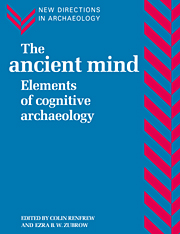Book contents
- Frontmatter
- Contents
- List of figures
- List of tables
- List of contributors
- Preface
- PART I INTRODUCTION
- PART II THE INTERDISCIPLINARY UNDERPINNING
- 2 Interpretation and testability in theories about prehistoric thinking
- 3 Archaeology and cognitive science
- 4 From domain specific to generalized intelligence: a cognitive interpretation of the Middle/Upper Palaeolithic transition
- 5 Are images animated? The psychology of statues in Ancient Greece
- PART III APPROACHES TO CULT PRACTICE AND TRANSCENDENTAL BELIEF SYSTEMS
- PART IV PREHISTORIC CONCEPTIONS OF SPACE AND TIME
- PART V THE MATERIAL BASIS OF COGNITIVE INFERENCE: TECHNOLOGY
- PART VI THE MATERIAL BASIS OF COGNITIVE INFERENCE: WRITING SYSTEMS
- PART VII CONCLUSION
- Index
3 - Archaeology and cognitive science
Published online by Cambridge University Press: 03 December 2009
- Frontmatter
- Contents
- List of figures
- List of tables
- List of contributors
- Preface
- PART I INTRODUCTION
- PART II THE INTERDISCIPLINARY UNDERPINNING
- 2 Interpretation and testability in theories about prehistoric thinking
- 3 Archaeology and cognitive science
- 4 From domain specific to generalized intelligence: a cognitive interpretation of the Middle/Upper Palaeolithic transition
- 5 Are images animated? The psychology of statues in Ancient Greece
- PART III APPROACHES TO CULT PRACTICE AND TRANSCENDENTAL BELIEF SYSTEMS
- PART IV PREHISTORIC CONCEPTIONS OF SPACE AND TIME
- PART V THE MATERIAL BASIS OF COGNITIVE INFERENCE: TECHNOLOGY
- PART VI THE MATERIAL BASIS OF COGNITIVE INFERENCE: WRITING SYSTEMS
- PART VII CONCLUSION
- Index
Summary
Introduction
Cognitive science is an interdisciplinary approach to studying mind and, in particular, intelligent thought and behaviour. It is a relatively new academic discipline which is developing from a merger of interests among certain linguists, psychologists, philosophers, computer scientists, anthropologists, neuroscientists and others (Norman 1981). Historically, however, cognitive science has not generally been extended to include archaeology or its issues. From the perspective of this cognitive scientist, however, it is obvious that archaeology could become a core cognitive science. The study of material culture is an important domain with unique data and methods which can contribute to the general understanding of intelligence. Also, archaeology can (and does) profit from data and methods developed in the other cognitive sciences.
In archaeology, a primary concern is what material culture tells us about the living culture that produced it. The artefacts and structures found at archaeological sites represent varying amounts of skill, knowledge and social organisation. By analysing these objects in the context of their appearance, one may be able to infer a great deal about their role in society and the intelligence that was necessary to create them and to use them. Research in cognitive science has shown that there are many constraints on how people solve problems and achieve other goals (Newell and Simon 1972; Newell 1981). Thus a cognitive archaeologist can study the objects and structures found at archaeological sites with an eye towards answering questions about the knowledge, purposes, practices and skills of the people who produced them.
- Type
- Chapter
- Information
- The Ancient MindElements of Cognitive Archaeology, pp. 22 - 28Publisher: Cambridge University PressPrint publication year: 1994
- 3
- Cited by



